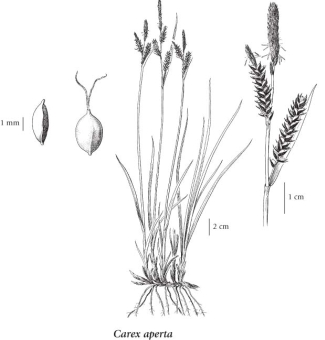Carex aperta Boott
Columbia sedge (Columbian sedge)
Cyperaceae (Sedge family)
Introduction to Vascular Plants
Columbia sedge (Columbian sedge)
Cyperaceae (Sedge family)
Introduction to Vascular Plants
Species Information
General:
Perennial, loosely or densely tufted herb from short rhizomes; stems triangular, with smooth edges, slightly rough below the inflorescence, 15-100 cm tall, exceeding the leaves.
Leaves:
Sheaths tight, short; blades flat, arising from the lower part of the stem, 2-6 mm wide, the lower ones slightly reduced.
Flowers:
The terminal spike or top 2 with male flowers, the lower 2 to 3 with female flowers and occasionally with a few male flowers at the top, unstalked or with short stalks, 1.5-4 cm long, erect; lowermost bract subtending the spikes leaflike, sheathless with brown ear-shaped lobes, usually shorter than or equalling the inflorescence, the upper ones reduced.
Fruits:
Perigynia egg- to globe-shaped, 2.5-2.8 mm long, 1.5-2 mm wide, green, inflated, nerveless, the beaks minute, up to 0.3 mm long; female scales egg-shaped, longer and narrower than the perigynia, purplish-brown, with lighter centres; stigmas 2; achenes lens-shaped, 1.3-1.7 mm long.
Illustration

If more than one illustration is available for a species (e.g., separate illustrations were provided for two subspecies) then links to the separate images will be provided below. Note that individual subspecies or varietal illustrations are not always available.
Illustration Source: The Illustrated Flora of British Columbia
USDA Species Characteristics
Flower Colour:
Brown
Blooming Period:
Early Spring
Fruit/Seed characteristics:
Colour: Brown
Present from Spring to Summer
Source: The USDA
Ecology
Ecological Framework for Carex aperta
The table below shows the species-specific information calculated from
original data (BEC database) provided by the BC Ministry of Forests and Range.
(Updated August, 2013)
The table below shows the species-specific information calculated from
original data (BEC database) provided by the BC Ministry of Forests and Range.
(Updated August, 2013)
| Site Information |
Value / Class |
||
|
Avg |
Min |
Max |
|
| Elevation
(metres) |
1913 | 1630 | 2200 |
| Slope
Gradient (%) |
5 | 0 | 15 |
|
Aspect (degrees) |
290 | 290 | 290 |
| Soil
Moisture Regime (SMR) [0 - very xeric; 4 - mesic; 8 - hydric] |
6 | 6 | 7 |
| Modal
Nutrient Regime
Class |
D | ||
| #
of field plots species was recorded in: |
3 | ||
| Modal
BEC Zone Class |
ESSF | ||
|
All BEC Zones (# of stations/zone) species was recorded in |
ESSF(3) | ||
|
Source:
Klinkenberg 2013
|
|||
Habitat and Range
Wet lake margins, riverbanks and meadows in the lowland, steppe and montane zones; frequent in S BC south of 55degreeN, infrequent in coastal BC, absent on the Queen Charlotte Islands and most of adjacent mainland; E to SW AB and S to MT, ID, and OR.Status Information
Synonyms
Synonyms and Alternate Names:
Carex accedens T. Holm
Carex acutina var. tenuior L.H. Bailey
Carex stylosa var. virens L.H. Bailey
Carex turgidula L.H. Bailey